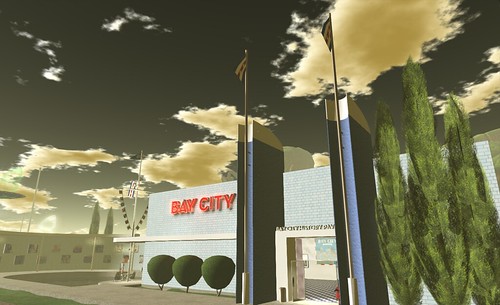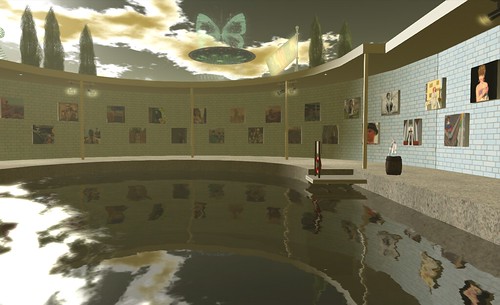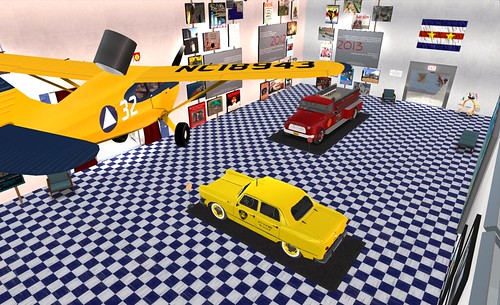Wednesday evening, I have the opportunity to sit down with Marianne McCann, the sim coordinator for the Beguile sim at SL10B and creator of the Second Life History Walk, Bay City History Pavilion, and other exhibits. Besides her work here at SL10B, Marianne maintains a very active Second Life. She is a long-time part of the child avatar community and an active member of Bay City, where she maintains her home and The Pen. She is the current head of the Bay City Alliance.
 |
| Sitting down for an interview with Marianne McCann at the Bay City History Pavilion |
Linsey: Why are you here? What made you want to become a sim-coordinator here at SL10B?
Marianne: Well, I've been a part of the event since the 3rd, though usually an an exhibitor. And last year, I helped pull together some support for SL9B, after the lab stepped aside from the event. That went so well that I was glad to be involved again this year.
 |
| Take a walk through the history of Second Life |
Linsey: How long have you been working on your exhibits here?
Marianne: Well, we got the land a couple months back, but my first duties were assisting with prep work, some work on Bear Island, etc.. I started on the welcome area about a month ago, then the history walk, then this History Pavilion, and last week the sculpture garden in SL10B Wonderous.
Linsey: I read in your interview with DRFran Babcock that you have an interest in World's Fairs from the mid- 20th century and put elements from them in your exhibits here. When did your research begin on these exhibits or was it something that you already knew enough about that you just had the concept in your head and built from that?
 |
| A closer look at one side of the History Walk |
Linsey: I read in your interview with DRFran Babcock that you have an interest in World's Fairs from the mid- 20th century and put elements from them in your exhibits here. When did your research begin on these exhibits or was it something that you already knew enough about that you just had the concept in your head and built from that?
Marianne: Oh ya. Well, not just the world's fairs. I'm actually a bit of a fan of the mis-century years. A bit before my time, but still a fascinating period. Still, I have looked a lot at photos and other materials from the World's Fairs over the years, so it tends to be a "first stop" when I start planning my birthday builds. I tend to think of them as being, in a way, Second Life's best example of a "world's fair," where avatars from all over the Grid come together and share some of the things that are unique about themselves with the rest of the Grid. So I tend to try and reflect that with my builds. I figure it it worked then, then there may be something that could work here and now.
Marianne: I don't necessarily go "well, this year I'll build the Marine Transportation Building from the 1939 New York World's Fair". But it tends to be "well, what sort of things to I want to do that say, "Bay City" and start flipping through websites and resources, and start tabbing different examples. In this case, ya, the aforementioned NYWF build seemed to fit, with a few modifications. Same with the history walk, where I borrowed elements from the venue of Flags from the 1933 Century of Progress.
Not directly copying the builds, but certainly grabbing some elements and ideas here and there.
Just hours before this interview, Linden Lab announced the release of the Materials Viewer.
Linsey: Speaking of history, would you call today a historic day in Second Life? How do you think the new Materials will effect residents daily life here?
Marianne: I think materials are part of a long history of great innovations. I think it's impact will be large, but perhaps not as big of a splash as say Mesh, or sculpts in their time, or flexible prims in theirs
Linsey: Do you have any plans of adding materials to any of your exhibits here?
Marianne: I actually did build with materials a bit at the history walk, but some last minute adjustments may have affected that. I did create normal and specular maps for the Bay City History Pavilion as well, but I ended up holding off on it for the moment. Maybe I'll sneak 'em in yet.
 |
| Bay City History Pavilion |
Linsey: We are sitting at the Bay City pavilion, one of the preplanned communities in Second. Life. This event is called the Second Life Community Celebration. You mentioned being a part of the Bay City and kids communities in SL. What does it mean to be a community in a virtual world where the normal geographic boundaries do not apply?
Marianne: Well, a community need not be geographic. One can be, for example, part of the Jewish community and not live in Israel. So, for example, being an SL kid means being part of a group of kids. I am a part of one of the big kid groups, and often interact with other SL kids here in the world, via school or camp roleplay, etc. But there are some geographic boundaries, for example Bay City. Where it is a block of 12 residential regions, and about that many more Linden controlled ones. And those of us who live in the Bay City regions have banded together in a lot of ways similar to any small town in first life, and would certainly see ourselves as a local community, with a certain home town pride, and local interest. So that is still possible, even in a world where one can teleport from one side of the Grid to another in a single instant.
Linsey: I guess that is what I was getting at, In Second Life there are none of the usual things that define us and group us together, such as geography , nationality, religion, etc. Here you can go anywhere and be anything, whenever you want. So what is it that makes a community. Is it just where you have your house or shop, or who you hang out with, or is it something more?
Marianne: I think it *can* be those things. But I also think it transcends that a bit. I mean, I have a neighbor right now in this world who has decided to erect a large spite fence and is feuding with myself and others. I can hardly claim to be in a "community" with someone who has opted out of same. But with the other neighbors.... sure! We share an experience. It's a communal experience. We are part of a shared community. And I think that's true in any world, any life, really.
 |
| Thew images of Bay City residents line the pool. |
Linsey: What do you hope that this exhibit conveys about the community of Bay City?
Marianne: Well, two things, really. Out here, I opted to be fairly simple. In the past, we've all hung banners showing our various businesses and projects in Bay City, but this year I suggested we go one step further in a way, and show us. We're what makes up the city, after all, so... here are our faces. Inside, I wanted to show our history, from when Bay City was first formed to today, via photos, ephemera, words, and even video. Really give some of the story of the city. At the same time, by doing a very in-theme structure and display, given another level of depth about the theme of the place.
 |
| A look inside the Bay City History Pavilion |
Linsey: Thank you for your time. I have one final question that I am asking everyone that I interview.
Marianne: My pleasure.
Linsey: The theme this year is "Looking Forward, Looking Back." It is easy to look back and see where we have been. It is harder to look forward and see exactly where we are going. What are you looking forward to in your Second Life in the short-term and in the long-term?
Marianne: In the short term... I am looking forward to the start of Camp HardKnock's Summer session in July. That's sort of a "vacation" for me. It's a role-play summer camp for kid avvies.
Marianne: Long term. That's the hard one. Really, I think it's watching for what is next. What new innovations, what new events, what new, cool content that I won't possibly be able to live without. The fun, the experiences yet to be had.
Be sure to stop by and check out the Second Life History Walk, and the Bay City History Pavilion before SL10B closes on June 29th.
Linsey

No comments:
Post a Comment